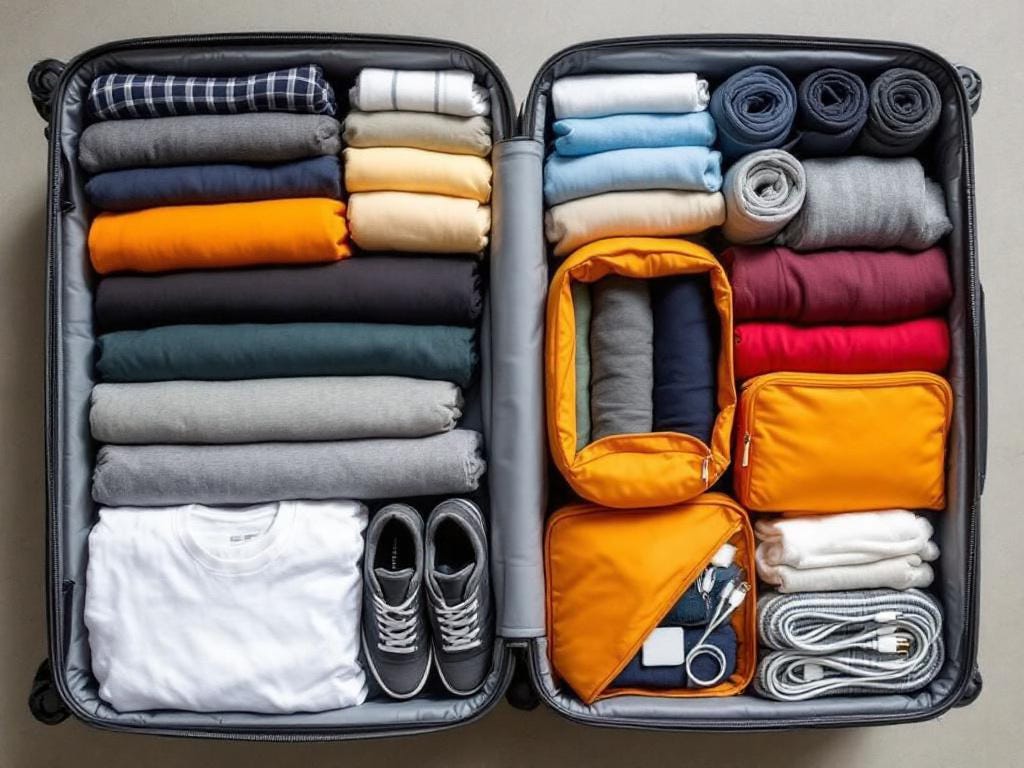Pack Like a Pilot: The 10-Day Carry-On System That Actually Works
No stress. No checked bags. Just ruthless simplicity that works
After logging over 10,000 flight hours and living out of carry-on bags for two decades, I've learned that packing isn't just about fitting everything in it's about creating a mobile command center that keeps you comfortable, prepared, and stress-free at 35,000 feet and beyond.
Today, I'm sharing “my” personal strategies I use to maximize space, minimize weight, and never pay another checked bag fee.
The Pilot's Packing Philosophy
Professional aviators operate on three core principles:
🎯 Redundancy without bulk: Critical items get backups, but everything else gets ruthlessly eliminated.
🎯 Multi-functionality: Every item should serve at least two purposes.
🎯 Accessibility: What you need most should be within arm's reach, even in a cramped airline seat.
The Foundation: Choosing Your Carry-On
Pilots swear by 22" or 21" x 14" x 9" soft-shell cases with four spinner wheels. The flexible structure adapts to tight overhead bins and offers more packing versatility. The expandable features are actually great when needed—perfect for return trips with souvenirs or when you need that extra inch of space.
Professional-grade brands that withstand daily airline abuse include
✅ Briggs & Riley (with their legendary lifetime warranty), this is the model l use to travel: Essential 22" Carry-On Expandable Spinner
✅ Travelpro (the choice of most flight crews) for example: Travelpro Platinum Elite Carry-On Spinner
✅ Tumi (for those who prioritize style with substance). These brands are at a high price point, but they will last for decades—understanding that luggage needs to survive baggage handlers, overhead bin compression, and thousands of miles of travel.
Pro tip: Your personal item should be a structured backpack that fits perfectly under the seat in front of you. This becomes your "flight deck"—containing everything you need during the flight. Check for more details what are personal items limits here on Traveling with Underseat Luggage & Personal Item Bags | Travelpro
The Capsule Wardrobe System
The 5-4-3-2-1 Rule
For Men - trips up to 10 days:
5 underwear/sock sets
4 t-shirts or base layers
3 pants/shorts
2 sweaters or layers
1 jacket or blazer
Fabric Selection
Pilots prioritize merino wool, synthetic blends, and non-iron shirts that:
Resist wrinkles naturally
Dry quickly in hotel bathrooms
Handle temperature variations
Look presentable after being compressed
Require minimal maintenance (especially non-iron dress shirts for business travel)
The Roll-and-Compress Method
Fold sleeves and sides inward to create a rectangle
Roll tightly from the bottom, expelling air as you go
Secure with a rubber band or compression cube
Stack rolled items vertically so you can see everything at once
Essential Items by Flight Duration
Short-Haul (Under 3 Hours)
Noise-canceling earbuds (not over-ear headphones)
Portable charger (10,000mAh minimum)
Compression socks (even on short flights)
Gum or mints for ear pressure
Digital entertainment downloaded offline
Medium-Haul (3-8 Hours)
Everything from short-haul, plus:
Neck pillow (inflatable to save space)
Eye mask and earplugs (absolute essentials for sleep anywhere—airplanes, hotels with thin walls, or bright city locations)
Moisturizer and lip balm (small containers)
Change of underwear in your personal item
Snacks (nuts, protein bars)
Long-Haul (8+ Hours)
Everything from medium-haul, plus:
Complete change of clothes in carry-on
Toiletry kit with toothbrush, toothpaste, deodorant
Slippers or compression socks
Melatonin for sleep regulation
Basic medications in original containers
The Pilot's Packing Order
Bottom Layer: Heavy and Structured
Shoes (wear your heaviest pair)
Jackets and coats
Jeans and heavy pants
Electronics and chargers
Middle Layer: Soft and Flexible
Rolled t-shirts and underwear
Lightweight sweaters
Pajamas or sleep clothes
Top Layer: Immediate Access
Toiletries (following 3-1-1 rule)
Documents and boarding passes
Snacks and medications
Items you'll need during flight
Space-Maximizing Strategies
The Shoe Trick
Pack socks, underwear, and chargers inside your shoes. Shoes are dead space otherwise, and this method protects delicate items.
The Hotel Safe Memory Hack: When using the hotel safe, always place one shoe inside it along with your valuables. You literally cannot leave the hotel without opening the safe to retrieve your shoe—guaranteeing you'll never forget your passport, jewelry, or electronics behind.
The Jacket Hack
Wear your heaviest jacket on the plane, not in your bag. Zip it up and use the pockets for additional storage phone chargers, snacks, even a small tablet.
Compression Cubes vs. Vacuum Bags
Compression cubes win for carry-ons because they:
Maintain shape under pressure
Allow partial access without unpacking everything
Come in standardized sizes that fit luggage dimensions
The "Dirty Clothes" Strategy
Pack a lightweight laundry bag. Dirty clothes compress better than clean ones, so your return packing is actually easier.
Avoiding Checked Bag Fees
Weight Distribution
Wear your heaviest items on the plane
Use your personal item for dense objects like books or electronics
Distribute weight between your carry-on and personal item
The 7-Pound Rule
Your personal item can typically be 7-10 pounds without raising eyebrows. Load it with:
Laptop and charger
Camera equipment
Heavy books or documents
Snacks and water bottle (empty through security)
Gate Check Insurance
Pack a small day pack inside your carry-on. If forced to gate-check, quickly transfer essentials to your day pack and carry it separately.
The Professional's Toiletry Kit
TSA-Compliant Essentials
Toothbrush and toothpaste (travel size)
Deodorant (solid, not aerosol)
Moisturizer (essential for dry cabin air)
Contact solution (if needed)
Lip balm (cabin air is brutal)
Technology & Security Essentials
Digital Preparedness
Always pack chargers in your personal item (never in checked luggage—you'll need them if bags are delayed)
Take a photo of your luggage contents before closing—invaluable for insurance claims if lost
Use a luggage tracker (AirTag or Tile) hidden in an interior pocket for peace of mind
Keep a pen on you at all times for customs forms and unexpected paperwork
Airport Navigation Mastery
Download airline apps and check in exactly 24 hours before departure for better seat selection
Screenshot boarding passes and gate info airports are battery killers and WiFi isn't always reliable
Pack an empty water bottle to fill after security (dehydration is your biggest enemy at altitude)
Hotel Room Intelligence
Request rooms between floors 3-7—above ground floor security risks, below where fire ladders typically reach
Pack a small flashlight for power outages or navigating unfamiliar rooms at night
Bring a rubber door wedge for extra security (slides under door, prevents forced entry)
International Travel Preparation
Pack an extra passport photo for visa applications or emergency replacements
Notify your bank of travel dates to avoid card blocks at the worst possible moment
Research local electrical outlets and bring the right adapter—not all "universal" adapters work everywhere
Health & Comfort Priorities
Pack hand sanitizer and wet wipes—planes and hotels are germ factories with quick turnarounds
Bring your own pillow case if you're particular about hotel linens (takes no space, huge comfort boost)
Pack a small first-aid kit with basic medications—aspirin, antacids, band-aids, any prescriptions
Money-Saving Strategies
Check if your credit card offers free airport lounge access, many premium cards include this perk
Pack substantial snacks to avoid overpriced airport food (nuts, protein bars, dried fruit)
Use hotel loyalty programs even for one-night stays—points add up faster than you think
Technology Organization
The Cable Management System
Use small pouches to separate charging cables
Bring universal adapters instead of multiple country-specific ones
Pack a USB hub to charge multiple devices from one outlet
Power Strategy
Portable charger (10,000mAh minimum)
Multi-device charging cable (USB-C to Lightning, micro-USB, etc.)
Powerbank such as Anker MagGo Power Bank
Wall adapter with multiple USB ports
Power strip/multi-outlet adapter: buy one on Amazon before your trip, not at the airport where they cost a fortune and selection is limited
Climate-Specific Modifications
Cold Weather Destinations
Layer system: Base layer, insulating layer, shell layer
Merino wool base layers (warm, odor-resistant, packable)
Packable down jacket (compresses to fist-size)
Hot Weather Destinations
Lightweight, breathable fabrics
UV protection: Hat, sunglasses, sunscreen
Quick-dry clothing for beach/pool activities
Always pack a swimsuit even business trips to warm destinations often have unexpected pool or beach opportunities
Reef-safe sunscreen (many destinations now ban harmful chemicals)
Business Travel
Wrinkle-resistant dress shirts
Packable blazer (wool or synthetic blend)
Dress shoes that work with multiple outfits
Steamer (small, travel-size)
The 24-Hour Rule
Before every trip, do a 24-hour bag test:
Pack everything you think you need
Wait 24 hours
Remove 20% of non-essential items
Ask: "What would I miss if it wasn't there?"
Emergency Preparedness
The "Just in Case" Essentials
Photocopy of passport and ID (separate from originals)
Emergency cash in local currency
Basic first aid items: Band-aids, pain relievers, allergy medication
Emergency contact information (written down, not just on phone)
Flight Delay Survival Kit
Portable phone charger
Protein bars or nuts
Empty water bottle (fill after security)
Entertainment downloaded offline
Comfortable socks for long terminal waits
The Return Journey
Souvenir Strategy
Leave 20% empty space in your carry-on for return items
Wear new purchases on the return flight
Use dirty laundry compression to create more space
Laundry Logistics
Pack a small detergent packet for mid-trip washing
Quick-dry items can be washed in hotel sinks
Roll dirty clothes tighter than clean ones
Hotel Room Luggage Safety
Never place your luggage on the hotel room floor always use the luggage stand, desk, or chair. Hotel floors, especially near beds, are prime real estate for bedbugs and other unwanted hitchhikers. Your luggage should live in the bathroom while you inspect the room, then move to an elevated, hard surface for the duration of your stay.
Final Checklist: The Pilot's Pre-Flight Inspection
24 Hours Before:
Check airline's carry-on restrictions
Verify passport/ID expiration dates
Download offline entertainment
Charge all devices
Day of Travel:
Wear heaviest shoes and jacket
Pack essentials in personal item
Distribute weight between bags
Keep documents easily accessible
At Security:
Liquids in easy-access pocket
Electronics ready for separate screening
Shoes easy to remove (avoid laces)
Belt and jewelry in personal item
The Bottom Line
Professional packing isn't about having the most expensive gear, it's about developing systems that work under pressure. Every pilot knows that the best equipment is the equipment you don't notice, and the best packing system is the one that becomes second nature.
Start with these fundamentals, adapt them to your travel style, and you'll never stress about luggage again. Your fellow passengers will wonder how you manage to glide through airports with such ease.
The secret? You're not just packing clothes you're building a mobile life support system that keeps you comfortable, prepared, and ready for anything the journey throws at you.
Safe travels, and remember: the best packing job is the one you don't have to think about.
What's your biggest packing challenge? Reply and let me know—I read every response and your questions often inspire future newsletters.
Pilot Nick
✈️ Lessons from the Flight Deck
📬 Get more cockpit insights and travel tips, subscribe free to Lessons From the Flight Deck for weekly updates that help you fly calm and confident or visit:
https://www.skycalm.org












My rule of thumb: make sure you always have your passport, phone, and wallet, don't overstress the rest. Anything else you forgot can be bought in a pinch.
If this is a carry on those are children’s shoes!!